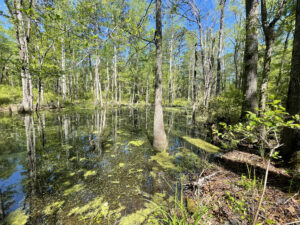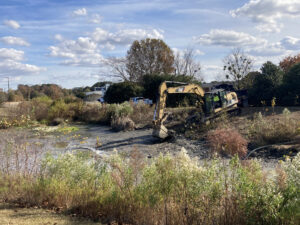News

A Murphy-Brown-owned swine facility West of Trenton, NC, where the lagoon has been over topped by flood waters.
Hurricane Florence- After the Flood
On September 13th, 2018 storm surge from Hurricane Florence began to affect the Eastern North Carolina region – pushing the Neuse and Pamlico Rivers above their banks and into towns, homes, and businesses. The storm continued to rage for days, at one point moving as slow as 2 miles per hour, drenching the area in historic amounts of rainfall. Just two years after the catastrophic flooding of Hurricane Matthew, our communities again were inundated with water. Initial reports say Hurricane Florence, which came ashore near Wilmington as a Category 1 hurricane, has caused approximately $15 billion in damage across North Carolina.
Estimates of the environmental and public health impacts are still being compiled. It will be some time before we know the full scale of the devastation caused by Hurricane Florence.
What we do know is this:
Sewer Spills Widespread: Most municipal wastewater systems in impacted counties had significant sewage spills. Wastewater systems are not capable of withstanding large amounts of rainfall; coupled with power outages, and in some cases, flooded treatment facilities, which likely resulted in millions of gallons released of raw or partially treated sewage into eastern NC waterways.
Coal Ash Spills: Your Upper Neuse Riverkeeper and Program Director discovered coal ash in Neuse River floodwaters after the storm at Duke Energy’s HF Lee facility. Water quality testing revealed that coal ash did indeed spill out of inactive basins, located along the river.
Industrial Animal Facility Waste Spills: Dozens of waste pits, storing millions of gallons of raw hog waste flooded, spilling the waste into nearby waterways. Several of these facilities were located along the Trent and Neuse Rivers. A report by the Environmental Working Group and Waterkeeper Alliance estimate that there are 123 industrial hog operations and 40 industrial poultry operations in or within 500 feet of the 100-year floodplain that received at least 15 inches of rain from the storm.
Public Health Infections: Data linking the impacts of Hurricane Florence to public health impacts will take some time to compile. However there were several reports of serious illness and death related to infections contracted in post-storm floodwaters. Numerous researchers are conducting post-storm bacteria testing, including the species vibrio, which can cause food poisoning via ingestion of raw shellfish or life-threatening infections from a wound.
We are only meant to experience the severe flooding resulting from Hurricane Florence once every five to ten centuries. Yet, this is the second time in two years we have dealt with this type of massive, region wide flood event. It is more imperative than ever that we begin to prepare for a future that includes more similar weather events. Your RIVERKEEPERs will continue fighting for changes that will protect our waterways, and the citizens of Eastern North Carolina.
Related News

Tell NC to restore wetlands protections!
April 19th 2024

Position available: Stormwater Education Coordinator
April 18th 2024

Southern Nash next in line for stormwater projects
April 18th 2024

Xylem, Sound Rivers team up for cleanup
April 18th 2024

Sound Rivers launches new podcast
April 18th 2024

Swim Guide gearing up for a seventh season
April 11th 2024

Feedback needed for Jack’s Creek plans, projects
April 11th 2024

Pamlico-Tar Riverkeeper talks water quality
April 11th 2024










